Climate Change-impacts and Adaptation for Cotton in Central India: Maharashtra
Info: 5846 words (23 pages) Dissertation
Published: 9th Dec 2019
Tagged: Environmental StudiesFamily
CLIMATE CHANGE-IMPACTS AND ADAPTATION FOR COTTON IN CENTRAL INDIA: MAHARASHTRA.
INTRODUCTION:
Climate change is crucial challenge the world is facing today. Climate Change is globally impacting on ecosystem, production of food, water supply, health. Climate has impact on agriculture production as well. Globally, effects of climate change on agriculture production are significant. Agricultural impact due to climate change will affect on security of food, government policies such as international and domestic, trades and their different patterns and resources use. Indian agriculture is facing challenges due to various parameters such as accelerated competition for land, water and labour from non-agricultural sectors and increasing climatic variability (Ahmed and Joshi, 2013). Global warming associated with fluctuating climate results in fluctuations in food production seasonally/annually. Even today, agricultural commodities are sensitive to such variability. The negative parameters that impact agricultural production and farmer’s live hood are environmental calamities such as extreme droughts and floods, cyclones, hot and extremes heat waves (Panda, 2016, Prabhakar and Shaw, 2008).
Direct inputs to agriculture are climatic factors and change in those factors causes reduction in crop yield and production. Climate change assumptions include higher temperature, changes in precipitation, and higher atmospheric CO2 concentrations. The warm and favourable environment is produced by greenhouse effect near earth’s surface which is hospitable for humans and other life forms to build up and bloom. However, the increased level of greenhouse gases (GHGs) caused an overall increase of the earth’s temperature which is driving earth towards global warming.
Since 19th century the average global temperature had been increase by 0.74 ºC and by 2100 AD with substantial regional variations, it is expected to increase by 1.4ºC – 5.8ºC (IPCC, 2007). Since last 10,000 years, the projected rate of warming is unheard. (Mahato, 2014).
Amongst all, globally, the fifth economically important cash crop is Cotton. The one of the biggest cotton producing country is India, which grows more than 12.0 Mha. On over 30.0 Mha worldwide in 2011–2012 (Figure 1) (http://www.cotton.org/econ/cropinfo/index.cfm). Indian cotton production facing qualitative and quantitative transformation .Depending on location of production climate change will have major impacts on trade and production of cotton. (Gerik et al., 1998).
India is world’s largest producer of cotton and the second-largest exporter. According to figures from International Cotton Advisory Committee (ICAC), in financial year to the end of March 2017, India produced about 5.97 million tons of cotton. According to estimation it seems that, cotton production will rise to 6.2 million tonnes in current financial year in India. Mostly, cotton is produced in arid and semi-arid climates. The fibre development largely affected by the geographic situation, soil status and identical environmental conditions dominating in cotton growing zones.
Central zone of India cultivates cotton as a full season crop, which constitutes states of Gujarat, Maharashtra and Madhya Pradesh (Figure 2). Maharashtra(98%) and Madhya Pradesh (80%) has been dominated by rainfed cotton cultivation, where climatic conditions are exclusively favourable for development of superior medium cotton and long staple cotton (Agarwal, 2009). Cotton cultivation on an area of 56.01 lakh hectares, produces 141.0 lakh bales, lending to 56.14 of the national production with an average productivity of 443 kg lint / ha (2005-2006) in central zone. About 97-98% area in Maharashtra is under rainfed condition, because of which largest area (29 to 30 lakh hectare) had lowest production of 46 lakh bales reporting to 32.76% area and hardly 18.97% for production in comparison with national average (Figure 3) (Deshpande, 2007).
For past years, agricultural scientists discovered that, extreme weather events like hailstorms, heat wave, frost, unseasonal and erratic rains have played havoc with cotton agriculture in Maharashtra.
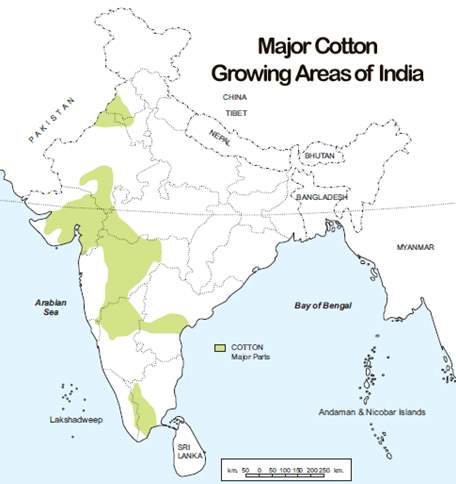
Figure 1: Cotton growing regions in India.
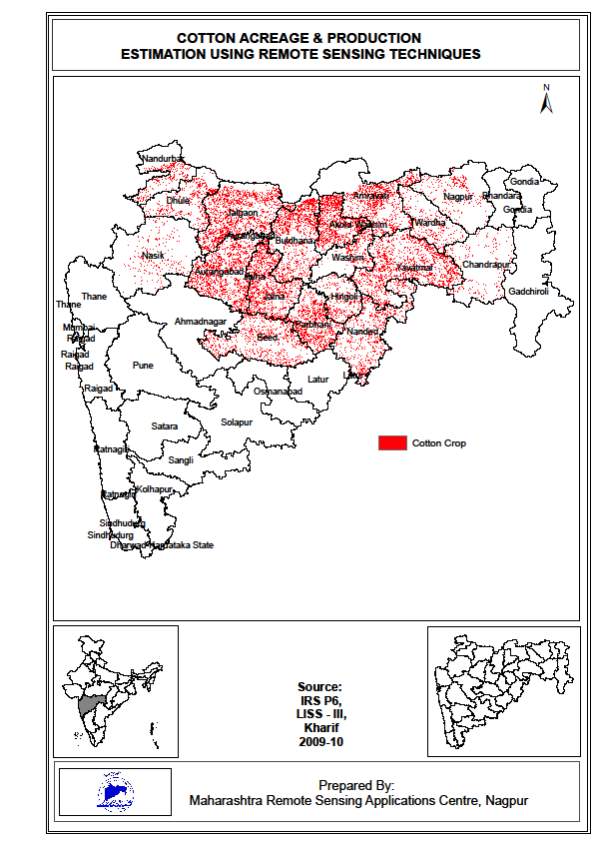
Figure 2: Cotton growing areas in Maharashtra. (Source: MRSAC)
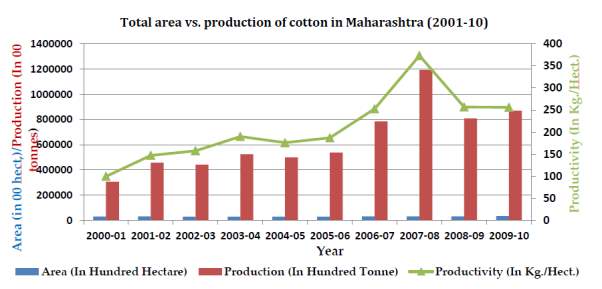
Figure 3 : Total area vs production of cotton in Maharashtra (Agarwal, 2009).
CURRENT AND PREDICTED CLIMATE CHANGES:
In colder climatic region, higher temperature could be beneficial for cotton yield by rendering longer growing season. However, cotton production could suffer in the region where temperatures already reach the to its maximum limit (Hebbar et al., 2013). The ability of cotton to survive in elevated temperature is largely depend on water availability and extremity of weather pattern, even though it can survive in hot climate. Cotton production is sensitive to frost too (greenbiz). The additional problem will be enhanced due to increased rainfall intensity during monsoon. Cotton development and fruit formation will be hampered by elevated temperature in already hot areas. Maharashtra grows rainfed cotton which will suffer due to increased climatic variability. Rain-fed cotton production in Maharashtra may suffer from climatic variability on large scale leading to conditions of drought and flooding (Hebbar et al., 2013).
Cotton needs suitable growing conditions of temperature, sunlight and soil moisture. Research states that 1-4oC increase in temperatures causes decrease in yield potential of crop. The period of dry season is necessary to opening of boll properly, which is substantial step of harvesting of cotton (Ton, 2011).
Key stages in cotton plant development are:
a) Suitable climatic conditions at time of planting.
b) Early season plant development.
c) Flowering at suitable climatic conditions.
d) Proper ball formation
e) Suitable climatic conditions at the end of season.
PROJECTION AND IMPACTS:
TEMPERATURE:
The projected increase in temperature over Maharashtra is shown in figure 4.The 1.85°C increase in temperature may shows no evidence of change in cotton yield in Maharashtra, however, a temperature rise of about 3.2°C can lead to a 268 kg/ha reduction in cotton yield (Kumar et al., 2011). Higher temperatures cause increased shedding of flower bud. The important reason for loss of fruit forms is elevated temperature. On the contrary, it is impossible to head off the effects of increased temperatures. (Reddy et al., 1997). Higher temperature affects not only bud but also fibre length. The length of fibre is longer when bolls grew at less than optimal temperatures (25°C). Fibre length distribution remains consistent with rise in temperature, but there is linear relationship between fibre fineness and maturity with the rise in temperature up to 26°C and decreased at 32°C (Bange and Milroy, 2004). At temperature 17 to 26°C short-fibre content declined linearly, while it was higher at elevated temperature. On the other hand, varying temperature regimes has little effect on most fibre quality traits. Thus, the maximum temperature for cotton flower and fruit period is 32º C (Pettigrew, 2007). Figure 4 and 5 gives the idea about projected increase in annual mean temperature of various districts of Maharashtra.
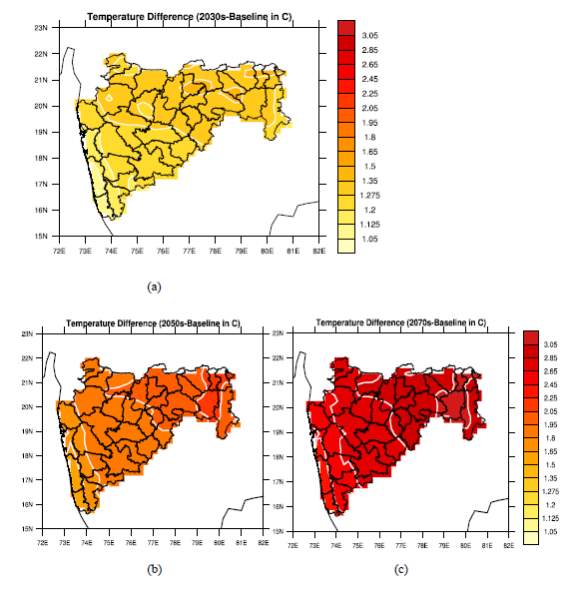
Figure 4: Projected increase in temperature over Maharashtra in (a) 2030s (b) 2050s (c) 20170s relative to baseline (in degree Celsius).
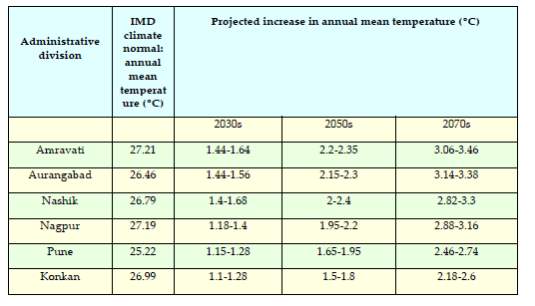
Figure 5. Division wise climatic projection of annual mean temperature.
CO2 concentration:
Increase in CO2 concentration is beneficial for some crops. While research found that, the net effect is negative if cotton is produced under 650 ppm elevated carbon dioxide level and 40oC temperature to improve its productivity (Reference: Vision 2025, CICR Perspective Plan, Central Institute for Cotton Research, Nagpur, ICAR).The effect of CO2 gets neutralized over time as temperature increases. CO2 increases photosynthetic activity. Higher lint yield can be achieved with increased number of branches and fruiting sites. This can be accomplished by increased atmospheric CO2 (ICAC , 2010).
Another impact of increased CO2 will be weeds will grow vigorously. Competition with weed become critical when seedling stage of cotton arrives. Most weeds are C4 plants while cotton is C3. The weeds consume more CO2 than cotton. C4 plants shows less reaction to CO2 and reduces or sometimes eliminates losses caused by photorespiration. Because of this cotton competes more effectively with the weeds when there is plenty of water and nutrients (Kaynak, 2007).Weed species become more dangerous when there is rise in temperatures. Hence weed control becomes more critical to achieve optimal cotton yield and its development (Kaynak, 2007).
Pests and diseases:
Rising temperature will cause increase in population of insects such as bollworm and emergence of new resistance due to high multiplication rate. Also, it will eliminate the diapause during winter to avoid low temperature. The condition of availability of alternate host plant for wintering will amplify the effect (ICAC, 2010). Relationship between insect incidence and weather parameters drives ecologically which have substantial economic impact on pest incidence. (Pandi, 1997) demonstrated that 390 kg/ha loss of seed cotton yield due to leafhopper. Increase in maximum temperature causes increase in leafhopper population on cotton plant while under complete protection i.e. during vegetative phase as well as reproductive phase. Relative humidity of morning time and evening time had positive and negative impact on larval population of pink bollworm respectively (Sankaranarayanan et al., 2010).Weather parameter contributed 90.9% on larval population (Patil et al., 1992).This study further evidenced the susceptibility of cotton pests.
RAINFALL:
Maharashtra receives annual average rainfall 1464 mm. Heavy rain curtails the sowing of cotton, particularly in black cotton soil affect the germination due to poor soil aeration. Maximum rainfall is observed from June to September. Figure 6 shows the trends of rainfall in various regions of Maharashtra indicating that slightly declining in kokan, while sharp decrease in Madhya Maharashtra during monsoon season. This causes increase in rainfall in post monsoon season (TERI, 2014).The change in rainfall season causes adverse effect on cotton by favouring the incidence of Heliothis spp.in cotton. Figure 7 shows district wise projected rainfall in 2030s,2050s,2070s.
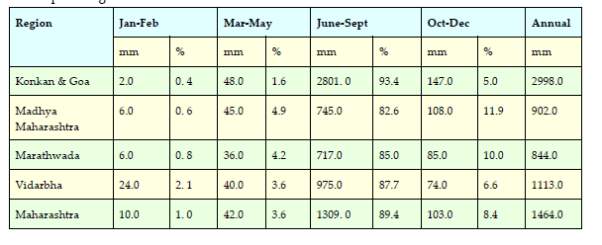
Figure 6: Season wise mean rainfall in different regions of Maharashtra state and its percentage with the mean annual rainfall. (TERI, 2014)
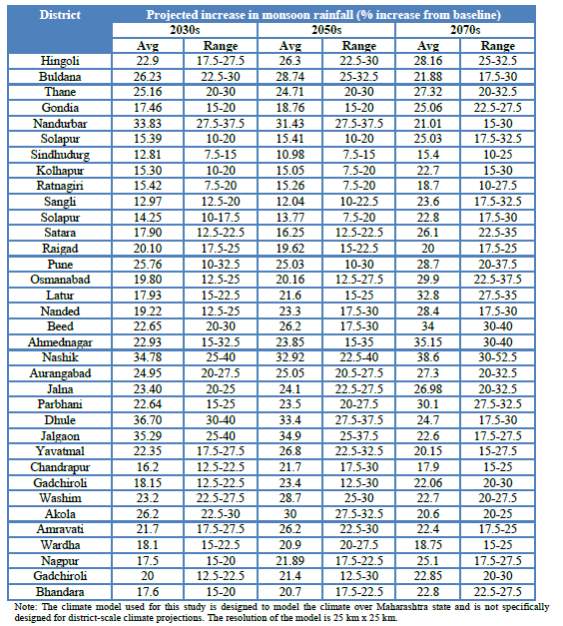
Figure 7: District wise climate change projection of Maharashtra.(TERI, 2014)
EXTREME EVENTS:
To accomplish optimum growth and yield of cotton, pest control becomes critical, with respect to increased temperature, drought and humidity. Additionally, atmospheric CO2 levels and rise in temperatures also have critical impact on effectiveness of certain pest management tools which are currently implemented like specific resistant varieties or use of insecticides. Genetically modified cotton (Bt cotton) shows decreased production of Bt toxin in leaves after exalted CO2, which affects plant-bollworm interaction. As a result plant becomes sensitive to bollworm attack, by early break down of resistance against it (Wu et al., 2007).
Elevated temperature reduces the effectiveness of some of the pesticides such as pyrethroids and spinosad reported by (Agarwal, 2009). Higher variability of climate contributing to periods of drought or flooding affects the rain-fed cotton production of Maharashtra (MOEF, 2004).
UV Radiation:
Projections indicate that climate change also lift level of solar ultraviolet-B (UV-B) radiation the earth’s surface future. UV-B radiation is readily absorbed by biomolecules (amino acids, polypeptides) and nucleic acids (Sullivan and Teramura, 1989).Reduction in vegetative and reproductive parameters due to exposure of high UV-B radiation left in smaller canopy which makes cotton sensitive to these radiations. The epicuticular wax content is enhanced by increased UV-B radiation on adaxial leaf surfaces and stomatal index on both adaxial and abaxial leaf surfaces. Exposure of UV-B also cause reduction in thickness of leaf. This causes no change in thickness of epidermal tissue. but, decreases the thickness of both palisade and mesophyll tissue (Kakani et al., 2003).(Zhao et al., 2003) reported that Higher level of UV-B radiation about 15.1 kJ/m2/day importantly reduces stem elongation rate, leaf area and accumulation of dry matter, while UV-B radiation at 7.7 kJ/m2/day has no effect on cotton growth and development. Predictors forecasts enhancement of UV-B radiation from 7.7 to 15.1 kJ/m2/day will occur from 30% diminution of ozone layer. Furthermore, forecasters observed that detrimental effect of elevated UV-B radiation on cotton growth and net photosynthesis rate will not be counterbalanced by increased atmospheric CO2.
ADAPTATION:
Economics of production is certainly altered due to changing climate. Hence cotton farming communities need to construct different adaptation schemes along with planting dissimilar crops and searching alternative income source other than farming. This implies complex and resource-intensive responses from government, private sector and international aid flows.
The research on cotton plant genome permits limited adaptations to cope up with changing climate (Kaynak, 2007)(ICAC2007). Cotton respond to stress by causing reduction in vegetation and fruiting parts such as bud, flower and bolls through compensatory growth. Cotton has vertical tap root system which proves positive against drought but becomes dangerous to water lodging.
The following mentions option can be used to adapt to changing climate:
- Deserting of burning of cotton and preventing soil should be implemented in the regions where it is currently implemented. Furthermore, preventing unnecessary loss of nutrients is another step towards adaptation for the farming system.
- Inclusion of cover crops or perennials is example of soil fertility management which should be favoured along with cropland design that has plant diversity (Ton, 2011).
- Adjusting sowing dates is reasonable solution to offset moisture stress, during warm period to prevent the crop from pathogen outbreaks. This adjustment will make most beneficial use of the length of growing season (Hebbar et al., 2002).
- Minimizing tillage operation provides valid solution to prevent loss of soil organic matter which is natural source of soil fertility and means of water storage for plant uptake. Tillage minimization also maintains soil’s integrity.
- Use of cotton varieties which are resistant to drought, heat stress, weeds, pests and diseases. Early maturing varieties escapes the pest attack wisely.
- Growing commodity prices of other crops such as maize, wheat provides appealing options for generating returns like cotton production. Rise in commodity prices offers economic crops which can be grown in rotation with cotton. This results in increase in cotton growth and yields.
- Using bioferlizers which are sustainable and natural sources. For instance, using nitrogen fixing crops such as legumes, compost and composted manure for natural nitrogen sources.
- Appropriate water use efficiency in irrigated cotton, because of irrigation water’s costs and carbon fuel footprint. Improved planning and construction of percolation tanks and check dams as a watershed management structures proves beneficial.
- Use of chemicals such as pesticides, herbicides and defoliants should be modified as well as limited due to their costs and carbon fuel footprint.
- Post-harvest management improvement is necessary with improvement in cold storage and warehousing with credit, providing subsidies and providing training on good practices to the farmers. This facilitates the total production and yield improvement along with adapted strategies.
- Frequent and localized weather forecast provision as well as crop specific consultation by agricultural consultants to encourage farmers for changing their cropping systems. This provides better solution to adaptation of climate change (e.g. delay sowing dates, protective irrigation).
- Emerging pests and pathogen in different agro climatic regions can be monitored using scaled up mobile based surveillance and institute forewarning system.
- Participation of non-loaned farmers can be encouraged by simplifying and explaining crop insurance to them (Singh et al., 2012b).
- Another promising adaption is modified crop mix and land use. Short duration intercropping vegetables like coriander, radish, vegetable cowpea, cluster bean and beetroot provide sustainable multi-tier combination along with cotton. Periodic and early harvest of intercrops resulted in less competition within the component of multi-tier crops leading to yield equal to sole cotton (Butt et al., 2006).
BARRIERS:
For sustainable productivity and profitability to the farmers, Adaptation is substantial criteria. In a real situation the changes in the system can be complicated whether it would be physical, economical, social or political. Farmers usually choose self-governing adaptations for such complex changes considering their adaptive capabilities and optimizing their resources. Generally, sections like marginal and smallholder farmers are disfavoured and are prohibited to such a measures of adaptations due to several constraints (Singh et al., 2012a). Figure 8 defines the conceptual grouping of barriers.
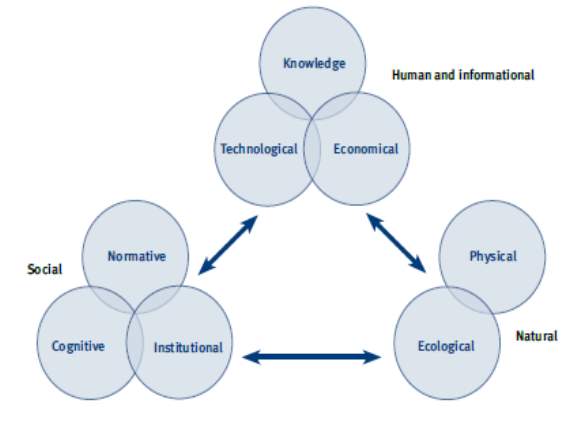
Figure 8: Conceptual grouping of limits and barriers to adaptation.
Some of barriers which are explained below:
- Field and farm level:
- Reduced availability of drought resistant varieties.
- Unavailability of potential technologies along with improved varieties as well as lack of access to information of changing climate.
- Incapacity for crop diversification as well as difficulty in supplementary irrigation.
- Institutional level:
- Unavailability of efficient market access to low income farmers.
- Incentives are unavailable to adopt to soil and water conservation practices
- Lack of efficient governance as well as efficient co-operative /association tackling risks.
- Diminishing public participation and incompatible administrative arrangements.
- Incapability of local governments to deal with the debilitating disasters such as droughts. State government demands additional funds from national government on regular basis when state suffers from drought or drought like situations (Sainath, 1996).
- Technological level:
- Ground water availability is decreased due to poor management.
- Lack of water efficient crop varieties and improved technologies to recharge ground water.
- Poor communication on information of water efficient cost.
- Social level:
- Globalization like more efficient infrastructures such as roads, hospitals, veterinary clinics etc.
- Shortage of labour, fragmentation of farms, population increase are the critical barriers.
- Absence of collective approach.
- Economic level:
- Unavailability of non-farm income during drought period (Singh et al., 2012a).
- Shortcomings in value present marketing system in state such as fragmented and long value chain and hence, specifically spoilable.
Transgenic Bt cotton as a barrier:
Transition phase in history of cotton cultivation is development of hybrid cotton for commercial cultivation. Cotton crops are affected by cotton bollworms, which becomes serious threat to cotton production. The Bt cotton developed against bollworm attack. The Bt phase is noticed by high yields, high input use, gradual dissolution of yield
advantage in the recent period, and the outgrowth of a new pest complex (Ramani and Thutupalli, 2015). Continuous use of hybrid cotton in large area, and reduced use of pesticides evoked the other pest attack on cotton eventually leads to low yields. Hybrids containing Bt gene were developed by private companies, forcing farmers to purchase seeds every year. The proprietary patent holders of the gene extract leases over the patent rights, thereby bringing up the seed cost (Ramasundaram et al., 2004). Thus, the technology and policies are critical determinant of performance of cotton crop, which results in contrasting performance of cotton during various phases. The increased input application of fertilizers is nothing but the effect of technological advantage of Bt cotton. This increases the cost of cotton production as well as making pest resistant to pesticides. Hence newer resistant pests are developing to sustain pesticides (Sabesh et al., 2014).
Solution to overcome barriers:
The study evaluated that, social barriers causes significant impact on successful adaptation strategies. The effect of cast, gender has predominated effect, but commonalities can be drawn with institutional restrictions associated with groupings such as, ethnicity, age and class. It is critical to take proactive step towards overcoming barriers to adaptation:
- Awareness, education and empowerment enhancement is at most necessary to overcome social barriers. Steps to provoke adaptation will not work out if government do not empower and individual who remain in cocoon with their adaptive behaviour and limited in their access to key resources.
- Mainstreaming of social barriers within wider adaptation policy framework is vital to address the limitation caused due to social barriers (Jones, 2010).
Changes in appropriate urban development, town planning, infrastructure legislation and state housing by state government is recommended.
Health and discipline to cotton system can be achieved by providing fare price to cotton farmers and effective input supply. The firm and ample supply of raw material required by textile industry can be ensured through contract farming and integrated cotton cultivation. Besides this, it also assures in improving productivity, reduction in cultivation costs, and increasing net returns to farmers. In international scenario Indian cotton can get esteemed place if the right policies, programmes and sincere efforts are assured (Gopalakrishnan et al., 2007).
CONCLUSION:
India faces a major threat from climate change because its economy is tied to agriculture, water and forestry which are most vulnerable climate sensitive sectors. India is the only country which produces various cultivated species of cotton on commercial scale which covers 8.5-9.0 million hectares. Hybrid cotton cultivation is spectacular milestone in Indian cotton scenario which covers around half of total cotton area.The requirement of cotton has been projected at 35.0 million bales by 2010,as a result of rapid growth in Indian economy and high demand of cotton due to cessation of Quota Regime and it can be increased tremendously in next 10 -20 years.
Major cotton producing areas are North zone, central zone and south zone. Amongst which Maharashtra cotton cultivation covers 41.67 lakh hectors of land. Cotton is important cash crop of Maharashtra and is largest producer of cotton. Around 36% of total are of country under cultivation is in Maharashtra. Maharashtra falls under rainfed region, where temperature rise is relatively less causing less impact of rise in temperature and may benefited from slight increase in rainfall. Therefore, cotton yield is not severely affected. Nationally, therefore, cotton production is unaffected with projected climate change. However, around 3.2°C rise in temperature reduces the yield. Moreover, increased CO2 level caused increase in photosynthetic activity could counterbalance for likely reduction of cotton yield caused due to high temperature. It also enhances the weed percentage which is competitor for cotton. Hence, it is important to control weeds to achieve maximum yield of cotton. Enhanced UV-B radiation also affects the cotton production by reducing cotton growth and photosynthetic rate.
On the pest management front, it has been stated that pink bollworm furnish inoculum for infestation of rainfed cotton during late summer amplifying feedback and long season irrigated cotton. This creates underlying conflict between two systems. Availability of insecticides for pink bollworm and other pests will induce the outbreak of highly damaging bollworms (or another pest). Rising CO2 also lowers the effect of Bt toxins produced by Bt hybrid cotton, which accelerates the susceptibility of pests.Significant increase in the utilization of GMO seed and the decrease in the productioncost will affect cotton production in a positive way.
Cotton production is affected by agricultural, industrial and commercial politics because it’s an important material for import and export in the world. Besides uncertainty in the production stages, instability in the price and market conditions have negative effect on the production. The adaptation strategies certainly provide better options to increase cotton production by positively affecting vegetative growth and diminishing the loss of fruiting parts caused due to environmental stress. There are economic, social, technological and institutional barriers which can be overcome by creating awareness about education and market availability, as well as updating government policies and technological improvement.
In all, as the climate change progresses cotton production will continue to exist. Like other living organism, it needs to adapt to changing environment.
REFERENCES:
AGARWAL, P. 2009. Global climate change and Indian agriculture. Indian Council of Agricultural Research, New Delhi.
AHMED, S. & JOSHI, M. 2013. impact of Climatic Parameter on Cotton Yield of Three Districts in Marathwada (Maharashtra). India International Journal of Statistika and Mathematika, ISSN, 2277-2790.
BANGE, M. & MILROY, S. 2004. Impact of short-term exposure to cold night temperatures on early development of cotton (Gossypium hirsutum L.). Australian journal of agricultural research, 55, 655-664.
BUTT, T. A., MCCARL, B. A. & KERGNA, A. O. 2006. Policies for reducing agricultural sector vulnerability to climate change in Mali. Climate policy, 5, 583-598.
DESHPANDE, L. 2007. LONG STAPLE COTTON SCENARIO IN MAHARASHTRA AND FUTURE PROSPECTS. Project Coordinator & Head, AICRP on Cotton, Coimbatore.
GERIK, T. J., OOSTERHUIS, D. M. & TORBERT, H. A. 1998. Managing cotton nitrogen. Adv Agron, 64, 115-147.
GOPALAKRISHNAN, N., MANICKAM, S. & PRAKASH, A. 2007. Problems and prospects of cotton in different zones of India. Project Coordinator & Head, AICRP on Cotton, Coimbatore.
HEBBAR, K., VENUGOPALAN, M., PRAKASH, A. & AGGARWAL, P. K. 2013. Simulating the impacts of climate change on cotton production in India. Climatic change, 118, 701-713.
HEBBAR, K., VENUGOPALAN, M., RAO, M., GADADE, G., CHATTERJI, S. & MAYEE, C. 2002. Effect of sowing dates and fertilizer levels on phenology, growth and yield of cotton. Indian Journal of Plant Physiology, 7, 380-383.
JONES, L. 2010. Overcoming social barriers to adaptation.
KAKANI, V., REDDY, K., ZHAO, D. & MOHAMMED, A. 2003. Effects of ultraviolet‐B radiation on cotton (Gossypium hirsutum L.) morphology and anatomy. Annals of Botany, 91, 817-826.
KAYNAK, M. A. 2007. Production problems in 2025. The Vision for Technology in 2025, 3.
KUMAR, S. N., AGGARWAL, P. K., RANI, S., JAIN, S., SAXENA, R. & CHAUHAN, N. 2011. Impact of climate change on crop productivity in Western Ghats, coastal and northeastern regions of India. Current Science, 332-341.
MAHATO, A. 2014. Climate change and its impact on agriculture. International Journal of Scientific and Research Publications, 4, 1-6.
MOEF, I.-U. 2004. India’s Initial National Communication to the United Nations Framework Convention on Climate Change. Ministry of Environment and Forests, Government of India.
PANDA, A. 2016. Exploring climate change perceptions, rainfall trends and perceived barriers to adaptation in a drought affected region in India. Natural Hazards, 84, 777-796.
PANDI, R. 1997. Ecology and Management of Leafhopper, Amrasca devastans (Distant) in cotton. M. Sc.(Ag.) Thesis. Tamil Nadu Agrl. Univ., Killikulam.
PATIL, S., NANDIHALLI, B., HUGAR, P. & SOMASEKHAR, P. 1992. Influence of weather parameters on pheromone trap catches of cotton bollworms. Karnataka J. agric. Sci, 5, 346-350.
PETTIGREW, T. High temperature effects on cotton yield, yield components, and fibre quality. Back to The ASA-CSSASSSA International Annual Meetings, November, 2007. 4-8.
PRABHAKAR, S. & SHAW, R. 2008. Climate change adaptation implications for drought risk mitigation: a perspective for India. Climatic Change, 88, 113-130.
RAMANI, S. V. & THUTUPALLI, A. 2015. Emergence of controversy in technology transitions: Green Revolution and Bt cotton in India. Technological Forecasting and Social Change, 100, 198-212.
RAMASUNDARAM, P., SABESH, M., SHENDE, N. & GAJBYE, H. 2004. Contribution of hybrids to cotton productivity. Hybrid Cotton Newsletter, 3.
REDDY, K. R., HODGES, H. F. & MCKINION, J. M. 1997. A comparison of scenarios for the effect of global climate change on cotton growth and yield. Functional Plant Biology, 24, 707-713.
SABESH, M., RAMESH, M., PRAKASH, A. & BHASKARAN, G. 2014. Is There any Shift in Cropping Pattern in Maharashtra after the Introduction of Bt. Cotton? Cotton Research Journal, 6, 63-70.
SAINATH, P. 1996. Everybody loves a good drought: stories from India’s poorest districts, Penguin Books India.
SANKARANARAYANAN, K., PRAHARAJ, C., NALAYINI, P., BANDYOPADHYAY, K. & GOPALAKRISHNAN, N. 2010. Climate change and its impact on cotton (Gossypium sp.). Indian Journal of Agricultural Sciences, 80, 561-575.
SINGH, N., BANTILAN, M., KATTARKANDI, B. & MURTY, M. 2012a. Tracking Adaptation Pathways and Identifying Strategies for Enhancing Grass-root Resilience to Climate Change Synthesis of Case Studies from Selected Countries of Asia (Bangladesh, China, India, Sri Lanka, Thailand and Viet Nam).
SINGH, N. P., BANTILAN, M., BYJESH, K. & MURTY, M. 2012b. Adapting to climate change in Agriculture: Building resiliency with an effective policy frame in SAT India.
SULLIVAN, J. H. & TERAMURA, A. H. 1989. The effects of ultraviolet‐B radiation on loblolly pine. I. Growth, photosynthesis and pigment production in greenhouse‐grown seedlings. Physiologia Plantarum, 77, 202-207.
TERI 2014. Assessing Climate Change Vulnerability and Adaptation strategies for Maharashtra. New Delhi: The Energy and Resources Institute.
TON, P. 2011. Cotton and climate change: impacts and options to mitigate and adapt. International Trade Centre, 1-17.
WU, G., CHEN, F. J., GE, F. & SUN, Y. C. 2007. Effects of elevated carbon dioxide on the growth and foliar chemistry of transgenic Bt cotton. Journal of Integrative Plant Biology, 49, 1361-1369.
ZHAO, D., REDDY, K., KAKANI, V., READ, J. & SULLIVAN, J. 2003. Growth and physiological responses of cotton (Gossypium hirsutum L.) to elevated carbon dioxide and ultraviolet‐B radiation under controlled environmental conditions. Plant, Cell & Environment, 26, 771-782.
Committe, I. C. (2010). ICAC . USA: ICAC.
Cite This Work
To export a reference to this article please select a referencing stye below:
Related Services
View allRelated Content
All TagsContent relating to: "Family"
Dissertations on many aspects of family matters including those related to parent-child communication and relationships, religion, family stressors and more.
Related Articles
DMCA / Removal Request
If you are the original writer of this dissertation and no longer wish to have your work published on the UKDiss.com website then please:




